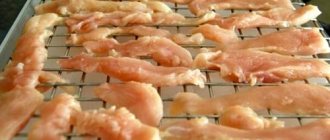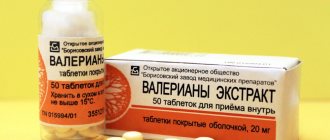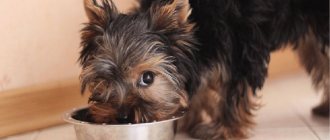Beef
The maximum benefit will come from carcass elements with veins and vessels, as well as trimmings with film and cartilage, as they prevent constipation and have a positive effect on stool. It is also important that they contain gelatin, which promotes the development and proper functioning of the dog’s joints and bones.
Giving your pet various offal products as the main component of the diet is undesirable, since they contain insufficient amounts of protein and have low nutritional value. Experts advise including no more than 15-20% of offal from the total food in the diet.
Poultry meat
In most cases we are talking about turkey and chicken. Chicken meat contains large amounts of potassium and phosphorus. At the same time, only homemade chicken is beneficial, since goods from the store are more likely to harm than have a positive effect on the functioning of the dog’s body.
Turkey meat contains potassium, sodium, iron, calcium and magnesium, as well as vitamins A and E. Sodium ensures the normalization of material metabolism. Turkey meat has minimal calorie content, contains little fat, and the dog’s body absorbs it well.
Should you serve the meat raw or cook it?
According to experts, heat treatment of meat does not have any effect on the quality of the product or its digestibility by the dog’s body. The biggest concern is protein loss during the cooking process. But in reality, the loss of this important component is only 2-7%. Moreover, even this indicator can be reduced if the product is placed in boiling water.
The four-legged stomach copes well with digesting boiled and raw meat, and both options have a positive effect on the dog’s body. In this regard, all owners need to make a personal decision on this issue. You just need to remember the following recommendations:
- When choosing raw meat, it is recommended to first freeze it for 48-72 hours in the freezer.
- Avoid purchasing meat of questionable origin.
How to prepare meat puree for babies?
Boiled meat must be passed through a blender and then through a sieve. Essentially, the algorithm is the same as when preparing minced meat, only the puree should be more uniform in mass.
Up to 10 months, the meat puree should be homogeneous.
You need to add ½ - 1 teaspoon of vegetable oil to the finished homemade meat puree.
For babies over 10 months old, you can cook meatballs or steamed cutlets - after a year. Ready minced meat can be frozen in the freezer.
It is not recommended to store boiled meat for baby food in the refrigerator for more than a day.
It is not recommended to add pepper, spices, or salt to meat puree. This may distort the taste of the meat dish, and the child may refuse to eat it.
Tips for feeding your pets meat
Experts give the following feeding recommendations:
- At least half of an adult dog's daily diet should come from meat. For sedentary four-legged animals, 15-20 g per 1 kg of weight is enough. But active dogs should be given approximately 30 g per 1 kg.
- The amount of meat and serving size may vary depending on the level of physical activity, the dog's health and the time of year.
- It is necessary to give the dog meat in such pieces that it cannot immediately swallow it. Chewing is very important to prevent plaque problems.
- To prevent parasite infestation, deworming measures should be taken periodically.
- The diet needs to be balanced. If you feed your pet only meat, over time there will be disruptions in the body's functioning. Be sure to include a variety of foods in your diet that contain fats, carbohydrates, proteins and fiber.
In conclusion, I would like to remind you that dogs should only be given meat that has passed veterinary control, thereby minimizing the risk of poisoning or the development of serious diseases.
Lamb in the diet of dogs
04.02.2019
Product Features
The benefits of lamb for dogs have been confirmed by veterinarians and nutritionists. Meat contains vitamins A, B, D, E, K. Easily digestible protein helps saturate the body and form muscle fibers. The product has a beneficial effect on metabolism and the circulatory system. The mineral compounds contained in it - magnesium, copper, iodine, phosphorus - are involved in the internal biochemical processes of the dog's body.
I would especially like to note that lamb meat is an environmentally friendly product. Since sheep are raised only on free grazing, on pasture. Antibiotics and feed are not used, only hay for feeding, and only when there is a lot of snow, because they are raised mainly only on pasture, on year-round grazing.
The big advantage is that it is easily available for sale and is available everywhere. Lamb also almost never causes allergies, this is because it is a rare protein in the diet of dogs, yet it is not as popular as beef and chicken, the protein of which most often causes reactions. Therefore, for animals with allergies, it is suitable for feeding as a mono diet (one type of meat) since it has many different sources of protein - pulp/cartilage/bones/liver/heart/stomach organs.
Many people are afraid to feed lamb because of its high fat content, but, for a moment, a healthy dog’s diet is normal to have up to 20% animal fats! (for understanding: lamb contains an average of 16-19 grams) And for very active ones who participate in sports, or are kept at very low temperatures, it’s all 25-30%. Therefore, this is more of an ideal fat content.
A dog takes energy from fats, and not from carbohydrates, as many people think... they have a protein-fat metabolism, so there is no need to be afraid. The only thing is that you need to make allowances for the animal’s activity, maintenance, and general tendency toward obesity, and then adjust the diet, choosing leaner parts or fattier ones.
IMPORTANT!!!
What is beneficial in lamb?
Lamb is the most popular and widespread meat, ideal for feeding dogs.
Sheep meat and liver contain many B vitamins - in particular vitamin B12, which is responsible for growth and development, increases hemoglobin levels and strengthens the immune system, ensures efficient functioning of the nervous system and promotes resilience. Lamb also contains:
- vitamin A (retinol, which is an antioxidant, normalizes metabolism, and also ensures good condition of the skin, coat, claws and teeth);
- vitamin B1 (thiamine, improves metabolism, participates in the metabolism of carbohydrates, fats and proteins);
- vitamin D (ensures the absorption of calcium and phosphorus in the intestines, is indispensable for the formation of bone tissue, and is necessary for the prevention of rickets in puppies);
- vitamin E (responsible for the hormonal and reproductive systems, is an antioxidant, ensures the stability of the nervous system, good condition of the skin and coat);
- vitamin K (improves the functioning of the circulatory system, promotes the absorption of calcium, which is especially important for puppies, pregnant bitches and older dogs).
Sheep meat contains a large number of useful mineral compounds - iron, sulfur, zinc, manganese, chlorine, iodine, phosphorus, magnesium and copper. Lamb meat contains proteins that are in an easily digestible form. They quickly saturate the dog’s body with energy and promote the formation of muscle fibers and bones. Meat contains practically no cholesterol and is a dietary product. Thanks to this, lamb stimulates metabolism, accelerates the synthesis of nutrients in the body, has a general strengthening effect, and improves immunity.
About the nutritional value of meat: it has a large amount of nutrients, especially such important ones as B vitamins, contains a lot of iron (the highest value, on par with venison), which makes this meat especially valuable for the recovery of sick and weakened animals, with low levels hemoglobin. This effect, of course, only comes from raw meat, scalded at most.
Due to the high % fat content, lamb is very high in calories, but in different parts of the carcass, the calorie value is different, for example: ham - 380kk, back - 458kk, brisket - 534kk, lamb ribs, the leanest, only 203kk, all these values are relative, after all, a lot depends on the age of the lamb, but since only the meat of young animals up to a year is on sale to people, we boldly focus on these numbers.
So, introduce lamb into your pet’s diet! It's healthy, environmentally safe, and delicious! Those who feed with natural food, raw meat, and lamb chews for entertainment, of which there is a wide choice: Biber, trachea, dried meat, various delicacies in pieces and in the form of sausages.
For those on dry food, you can feed the delicacy as part of the ration, during training, not forgetting that it is very nutritious, although less fatty than the raw product, due to the fact that during drying, the fat from the compression of the pulp is squeezed out, and during the production process, it is easily removed , which also makes it convenient - it doesn’t get your hands dirty.
The treat can replace one feeding, or simply cut down on food intake that day.
Who is it suitable for?
Lamb can be given to any size dog. But this meat is especially useful for guard and herding breeds. After all, their body adapted to such food many centuries ago. Nutritious lamb quickly saturates animals that move actively and spend a lot of energy (sled dogs, service dogs, runners).
Sheep and ram meat is suitable for allergy sufferers, as it practically does not cause individual intolerance. A variety of healthy by-products allows you to diversify the diet of a pet on a strict diet.
Lamb is rich in iron, microelements, and B vitamins, which makes it an ideal dish for older and weakened dogs. Fresh raw meat is especially beneficial. To kill helminths, you can freeze it overnight or scald it with boiling water.
Menu creation
Large breed dogs can be fed raw meat or organ meats in one piece. Films, veins and cartilage do not need to be removed. They also contain valuable nutrients. For better absorption, it is recommended to add fresh or steamed vegetables to the bowl.
Puppies over 30 days old are given minced meat. When your pet has molars, you can give him meat cut into small pieces. By-products are scalded with boiling water, crushed, mixed with porridge, vegetable mixture, and fermented milk products. It is recommended to give large lamb bones to dogs only in raw form. A small bone can delaminate and damage the walls of the gastrointestinal tract.
Meat and offal, dried and dried, can be used as a reward for completed commands. Such treats are tasty and safe for health. They do not crumble, do not stain your hands, and do not contain harmful components. The only caveat is that you need to adjust your daily calorie intake, since these tasty morsels are quite nutritious.
We are of the opinion that the optimal way to feed canines is natural meat with the addition of offal and vegetables; dairy products, poultry and fish can be given separately.
Some people add porridge to their dog's food. In this case, it is better to give meat as a separate feeding. For those who mix porridge with meat, there is no need to cook the meat!
The greatest amount of nutrients is in raw meat.
Bones are given to dogs ONLY raw! Boiled bones should never be given to dogs under any circumstances.
Daily ration
Meat and liver should make up approximately 30% of the total diet. If a dog lives in an apartment and walks near the entrance, he needs 20 grams of protein per 1 kg of weight.
Active dogs of working, service or sled breeds require 30-40 grams of protein food per 1 kg of weight.
The total daily ration is the following numbers.
| Breeds | Puppy | Adult | Elderly |
| Small (up to 10 kg) | 50-100 g | 100-200 g | 150-200 g |
| Medium (10-25 kg) | 200-300 g | 300-500 g | 400-500 g |
| Large (from 25 kg) | 500-700 g | 700-1000 g | 800-1000 g |
The protein intake is increased for older and weakened dogs. For them, buy only fresh meat products and feed them raw.











